Jinyoung Choi
Enhanced Diffusion Sampling via Extrapolation with Multiple ODE Solutions
Apr 02, 2025Abstract:Diffusion probabilistic models (DPMs), while effective in generating high-quality samples, often suffer from high computational costs due to their iterative sampling process. To address this, we propose an enhanced ODE-based sampling method for DPMs inspired by Richardson extrapolation, which reduces numerical error and improves convergence rates. Our method, RX-DPM, leverages multiple ODE solutions at intermediate time steps to extrapolate the denoised prediction in DPMs. This significantly enhances the accuracy of estimations for the final sample while maintaining the number of function evaluations (NFEs). Unlike standard Richardson extrapolation, which assumes uniform discretization of the time grid, we develop a more general formulation tailored to arbitrary time step scheduling, guided by local truncation error derived from a baseline sampling method. The simplicity of our approach facilitates accurate estimation of numerical solutions without significant computational overhead, and allows for seamless and convenient integration into various DPMs and solvers. Additionally, RX-DPM provides explicit error estimates, effectively demonstrating the faster convergence as the leading error term's order increases. Through a series of experiments, we show that the proposed method improves the quality of generated samples without requiring additional sampling iterations.
FIFO-Diffusion: Generating Infinite Videos from Text without Training
May 19, 2024


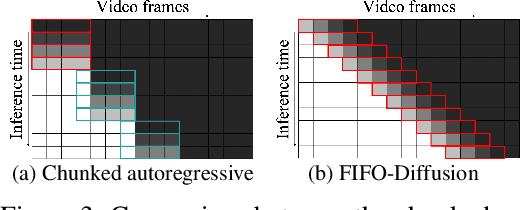
Abstract:We propose a novel inference technique based on a pretrained diffusion model for text-conditional video generation. Our approach, called FIFO-Diffusion, is conceptually capable of generating infinitely long videos without training. This is achieved by iteratively performing diagonal denoising, which concurrently processes a series of consecutive frames with increasing noise levels in a queue; our method dequeues a fully denoised frame at the head while enqueuing a new random noise frame at the tail. However, diagonal denoising is a double-edged sword as the frames near the tail can take advantage of cleaner ones by forward reference but such a strategy induces the discrepancy between training and inference. Hence, we introduce latent partitioning to reduce the training-inference gap and lookahead denoising to leverage the benefit of forward referencing. We have demonstrated the promising results and effectiveness of the proposed methods on existing text-to-video generation baselines.
PECI-Net: Bolus segmentation from video fluoroscopic swallowing study images using preprocessing ensemble and cascaded inference
Mar 21, 2024Abstract:Bolus segmentation is crucial for the automated detection of swallowing disorders in videofluoroscopic swallowing studies (VFSS). However, it is difficult for the model to accurately segment a bolus region in a VFSS image because VFSS images are translucent, have low contrast and unclear region boundaries, and lack color information. To overcome these challenges, we propose PECI-Net, a network architecture for VFSS image analysis that combines two novel techniques: the preprocessing ensemble network (PEN) and the cascaded inference network (CIN). PEN enhances the sharpness and contrast of the VFSS image by combining multiple preprocessing algorithms in a learnable way. CIN reduces ambiguity in bolus segmentation by using context from other regions through cascaded inference. Moreover, CIN prevents undesirable side effects from unreliably segmented regions by referring to the context in an asymmetric way. In experiments, PECI-Net exhibited higher performance than four recently developed baseline models, outperforming TernausNet, the best among the baseline models, by 4.54\% and the widely used UNet by 10.83\%. The results of the ablation studies confirm that CIN and PEN are effective in improving bolus segmentation performance.
* 20 pages, 8 figures,
A Training-Free Defense Framework for Robust Learned Image Compression
Jan 22, 2024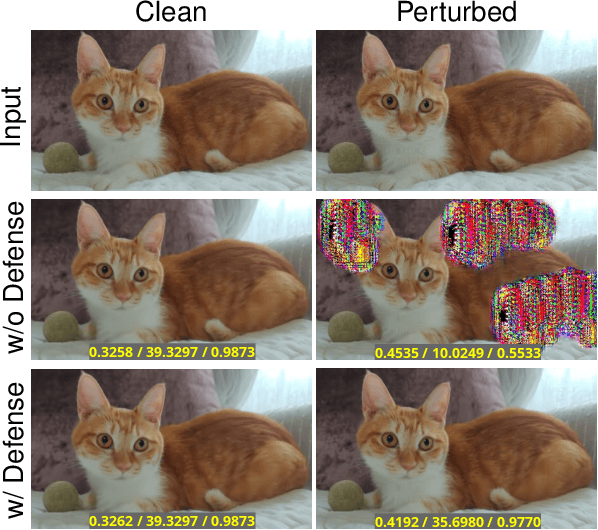
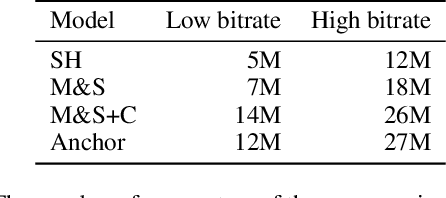
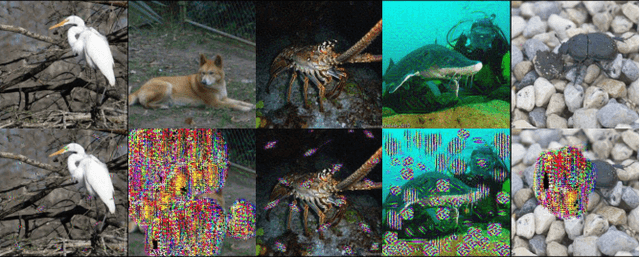

Abstract:We study the robustness of learned image compression models against adversarial attacks and present a training-free defense technique based on simple image transform functions. Recent learned image compression models are vulnerable to adversarial attacks that result in poor compression rate, low reconstruction quality, or weird artifacts. To address the limitations, we propose a simple but effective two-way compression algorithm with random input transforms, which is conveniently applicable to existing image compression models. Unlike the na\"ive approaches, our approach preserves the original rate-distortion performance of the models on clean images. Moreover, the proposed algorithm requires no additional training or modification of existing models, making it more practical. We demonstrate the effectiveness of the proposed techniques through extensive experiments under multiple compression models, evaluation metrics, and attack scenarios.
Observation-Guided Diffusion Probabilistic Models
Oct 06, 2023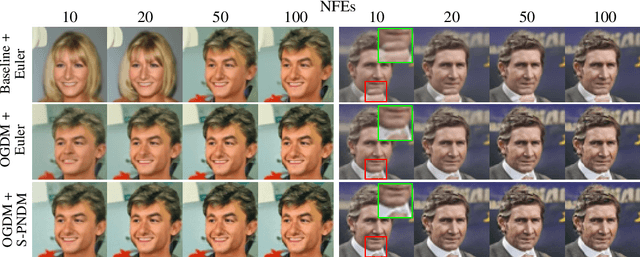
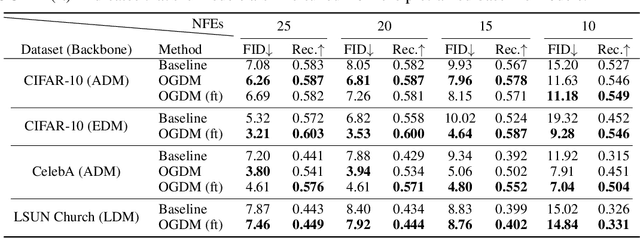


Abstract:We propose a novel diffusion model called observation-guided diffusion probabilistic model (OGDM), which effectively addresses the trade-off between quality control and fast sampling. Our approach reestablishes the training objective by integrating the guidance of the observation process with the Markov chain in a principled way. This is achieved by introducing an additional loss term derived from the observation based on the conditional discriminator on noise level, which employs Bernoulli distribution indicating whether its input lies on the (noisy) real manifold or not. This strategy allows us to optimize the more accurate negative log-likelihood induced in the inference stage especially when the number of function evaluations is limited. The proposed training method is also advantageous even when incorporated only into the fine-tuning process, and it is compatible with various fast inference strategies since our method yields better denoising networks using the exactly same inference procedure without incurring extra computational cost. We demonstrate the effectiveness of the proposed training algorithm using diverse inference methods on strong diffusion model baselines.
Variable-Rate Deep Image Compression through Spatially-Adaptive Feature Transform
Aug 21, 2021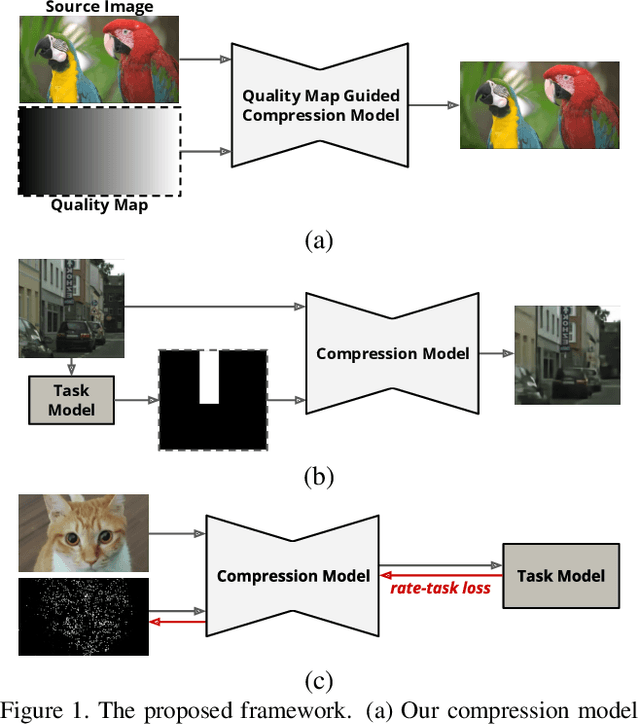

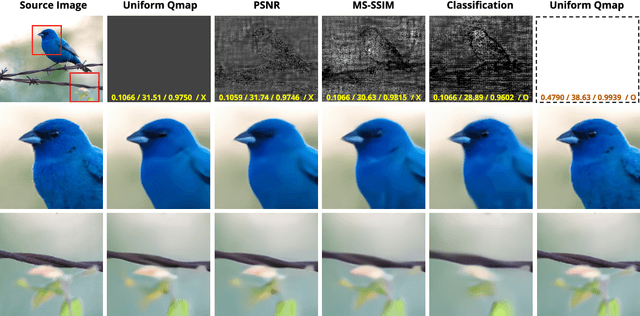
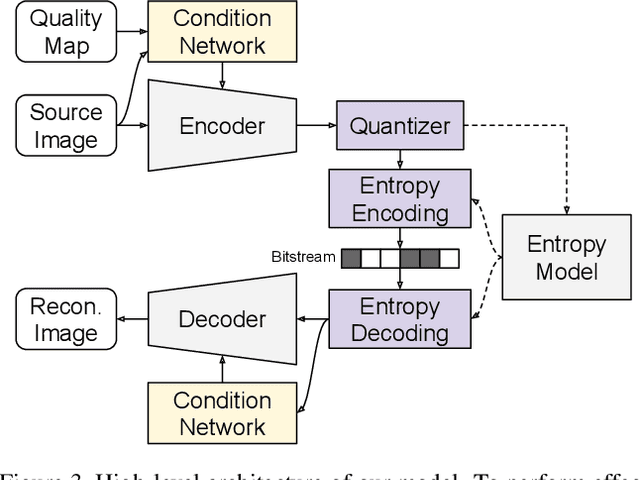
Abstract:We propose a versatile deep image compression network based on Spatial Feature Transform (SFT arXiv:1804.02815), which takes a source image and a corresponding quality map as inputs and produce a compressed image with variable rates. Our model covers a wide range of compression rates using a single model, which is controlled by arbitrary pixel-wise quality maps. In addition, the proposed framework allows us to perform task-aware image compressions for various tasks, e.g., classification, by efficiently estimating optimized quality maps specific to target tasks for our encoding network. This is even possible with a pretrained network without learning separate models for individual tasks. Our algorithm achieves outstanding rate-distortion trade-off compared to the approaches based on multiple models that are optimized separately for several different target rates. At the same level of compression, the proposed approach successfully improves performance on image classification and text region quality preservation via task-aware quality map estimation without additional model training. The code is available at the project website: https://github.com/micmic123/QmapCompression
MCL-GAN: Generative Adversarial Networks with Multiple Specialized Discriminators
Jul 15, 2021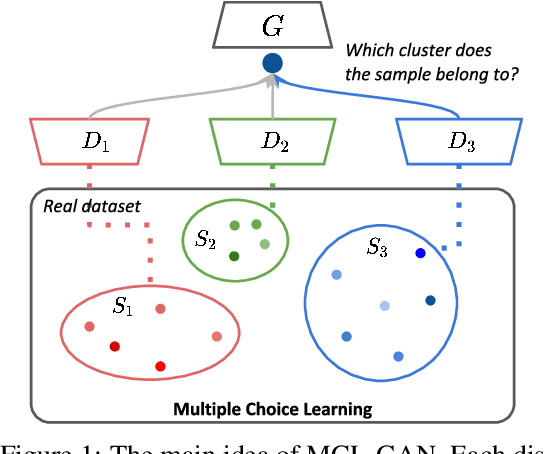
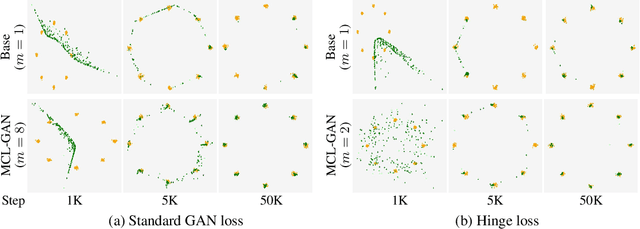
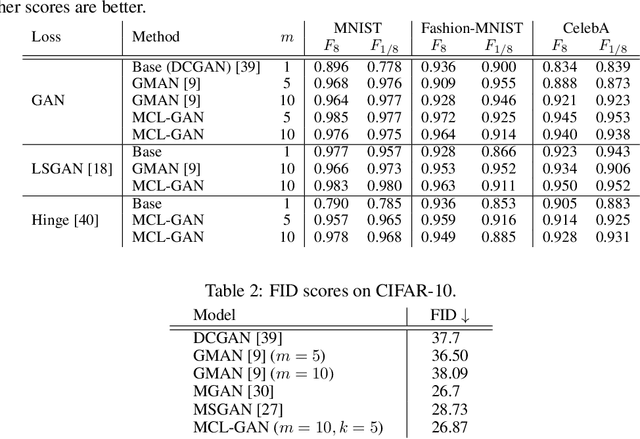
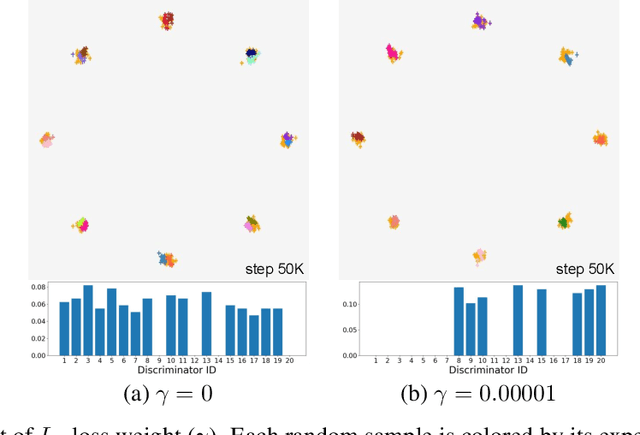
Abstract:We propose a generative adversarial network with multiple discriminators, where each discriminator is specialized to distinguish the subset of a real dataset. This approach facilitates learning a generator coinciding with the underlying data distribution and thus mitigates the chronic mode collapse problem. From the inspiration of multiple choice learning, we guide each discriminator to have expertise in the subset of the entire data and allow the generator to find reasonable correspondences between the latent and real data spaces automatically without supervision for training examples and the number of discriminators. Despite the use of multiple discriminators, the backbone networks are shared across the discriminators and the increase of training cost is minimized. We demonstrate the effectiveness of our algorithm in the standard datasets using multiple evaluation metrics.
Risk-Conditioned Distributional Soft Actor-Critic for Risk-Sensitive Navigation
Apr 09, 2021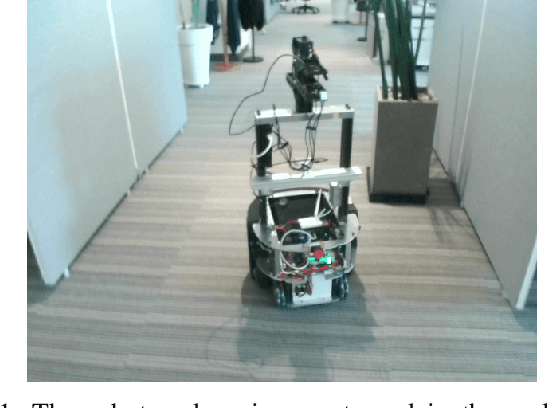
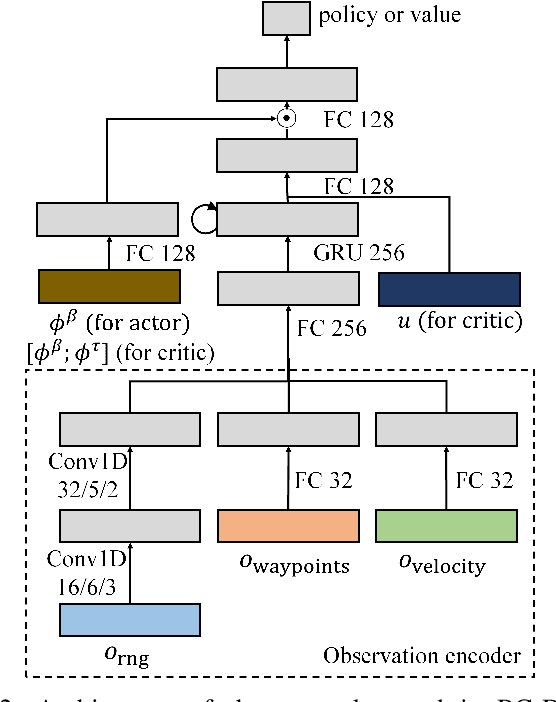
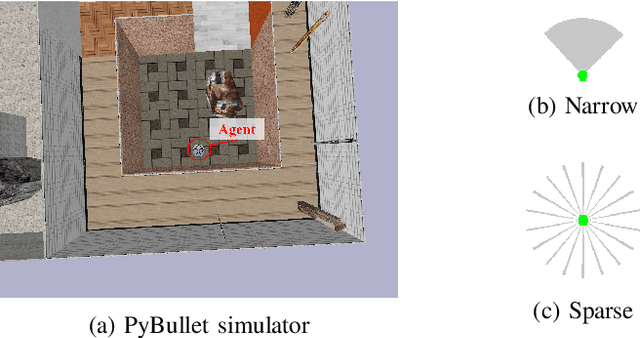
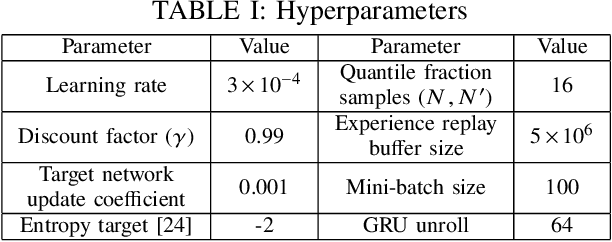
Abstract:Modern navigation algorithms based on deep reinforcement learning (RL) show promising efficiency and robustness. However, most deep RL algorithms operate in a risk-neutral manner, making no special attempt to shield users from relatively rare but serious outcomes, even if such shielding might cause little loss of performance. Furthermore, such algorithms typically make no provisions to ensure safety in the presence of inaccuracies in the models on which they were trained, beyond adding a cost-of-collision and some domain randomization while training, in spite of the formidable complexity of the environments in which they operate. In this paper, we present a novel distributional RL algorithm that not only learns an uncertainty-aware policy, but can also change its risk measure without expensive fine-tuning or retraining. Our method shows superior performance and safety over baselines in partially-observed navigation tasks. We also demonstrate that agents trained using our method can adapt their policies to a wide range of risk measures at run-time.
Multi-focus Attention Network for Efficient Deep Reinforcement Learning
Dec 13, 2017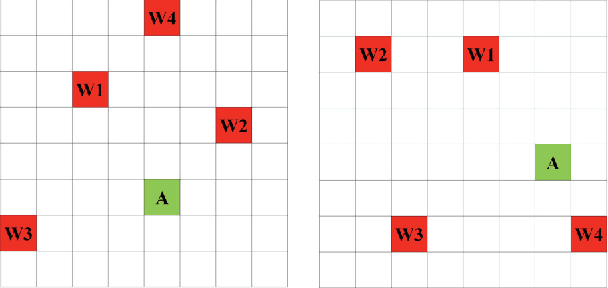

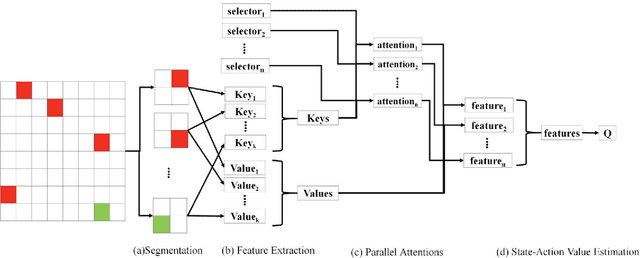
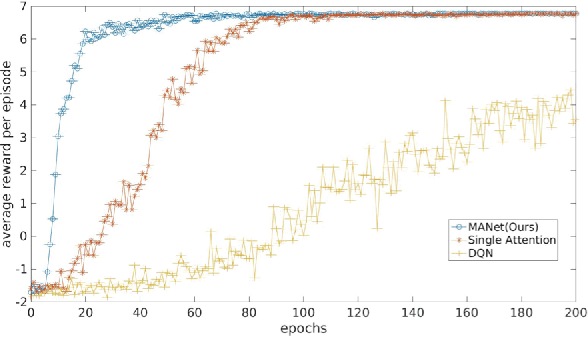
Abstract:Deep reinforcement learning (DRL) has shown incredible performance in learning various tasks to the human level. However, unlike human perception, current DRL models connect the entire low-level sensory input to the state-action values rather than exploiting the relationship between and among entities that constitute the sensory input. Because of this difference, DRL needs vast amount of experience samples to learn. In this paper, we propose a Multi-focus Attention Network (MANet) which mimics human ability to spatially abstract the low-level sensory input into multiple entities and attend to them simultaneously. The proposed method first divides the low-level input into several segments which we refer to as partial states. After this segmentation, parallel attention layers attend to the partial states relevant to solving the task. Our model estimates state-action values using these attended partial states. In our experiments, MANet attains highest scores with significantly less experience samples. Additionally, the model shows higher performance compared to the Deep Q-network and the single attention model as benchmarks. Furthermore, we extend our model to attentive communication model for performing multi-agent cooperative tasks. In multi-agent cooperative task experiments, our model shows 20% faster learning than existing state-of-the-art model.
Micro-Objective Learning : Accelerating Deep Reinforcement Learning through the Discovery of Continuous Subgoals
Mar 11, 2017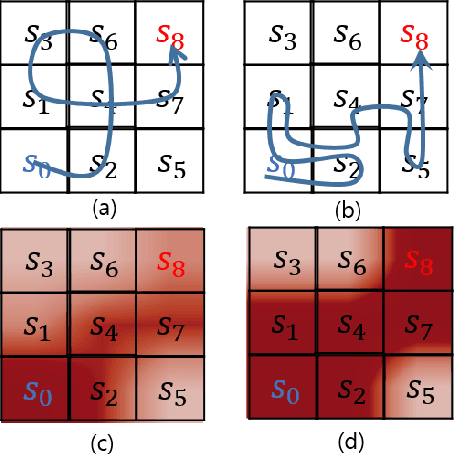

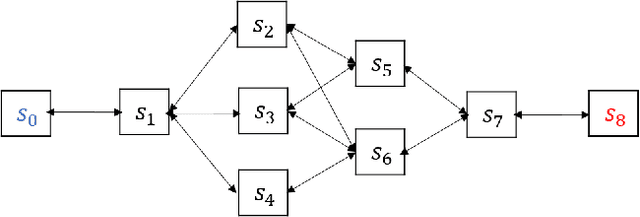
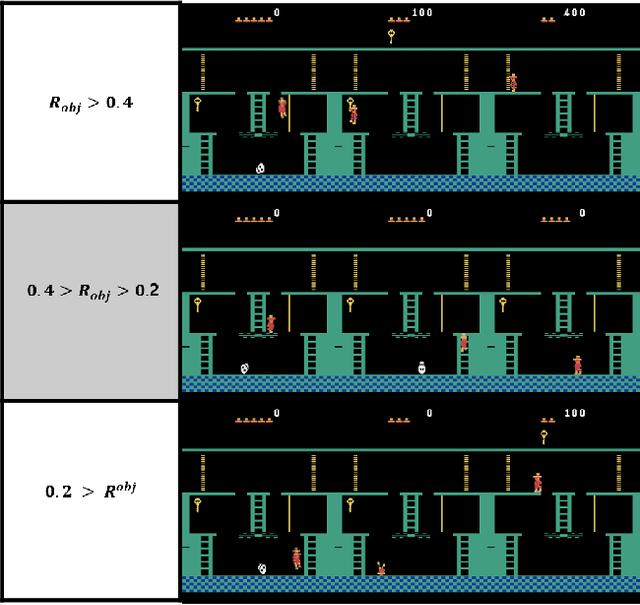
Abstract:Recently, reinforcement learning has been successfully applied to the logical game of Go, various Atari games, and even a 3D game, Labyrinth, though it continues to have problems in sparse reward settings. It is difficult to explore, but also difficult to exploit, a small number of successes when learning policy. To solve this issue, the subgoal and option framework have been proposed. However, discovering subgoals online is too expensive to be used to learn options in large state spaces. We propose Micro-objective learning (MOL) to solve this problem. The main idea is to estimate how important a state is while training and to give an additional reward proportional to its importance. We evaluated our algorithm in two Atari games: Montezuma's Revenge and Seaquest. With three experiments to each game, MOL significantly improved the baseline scores. Especially in Montezuma's Revenge, MOL achieved two times better results than the previous state-of-the-art model.
 Add to Chrome
Add to Chrome Add to Firefox
Add to Firefox Add to Edge
Add to Edge